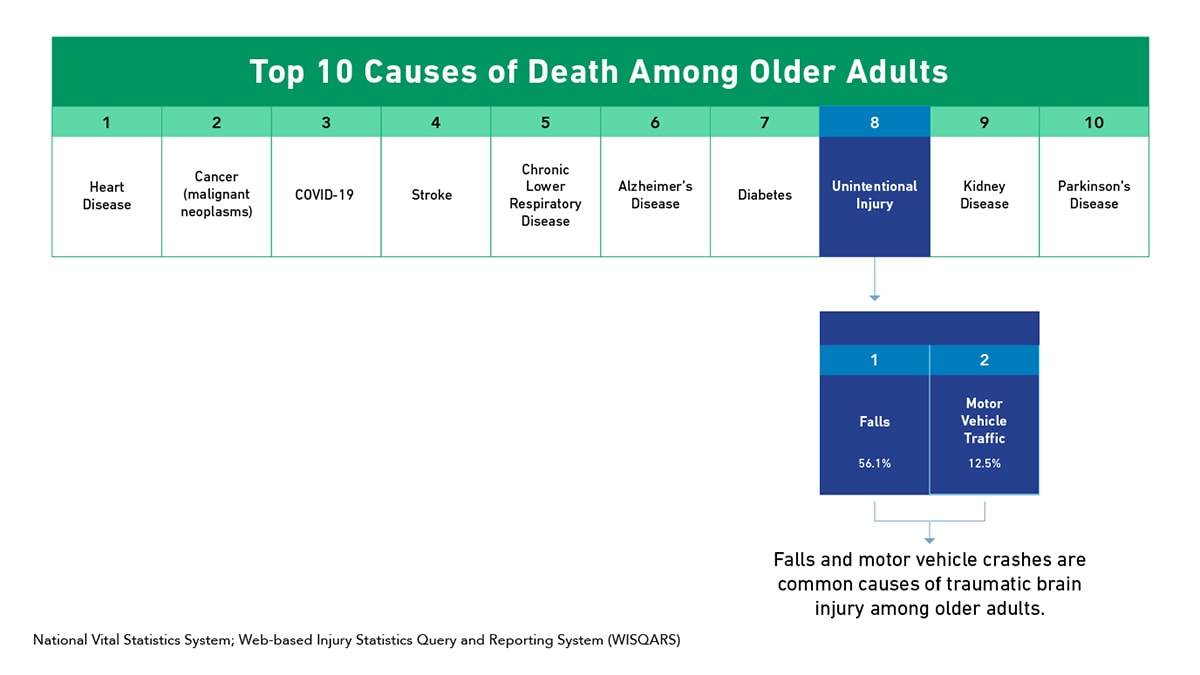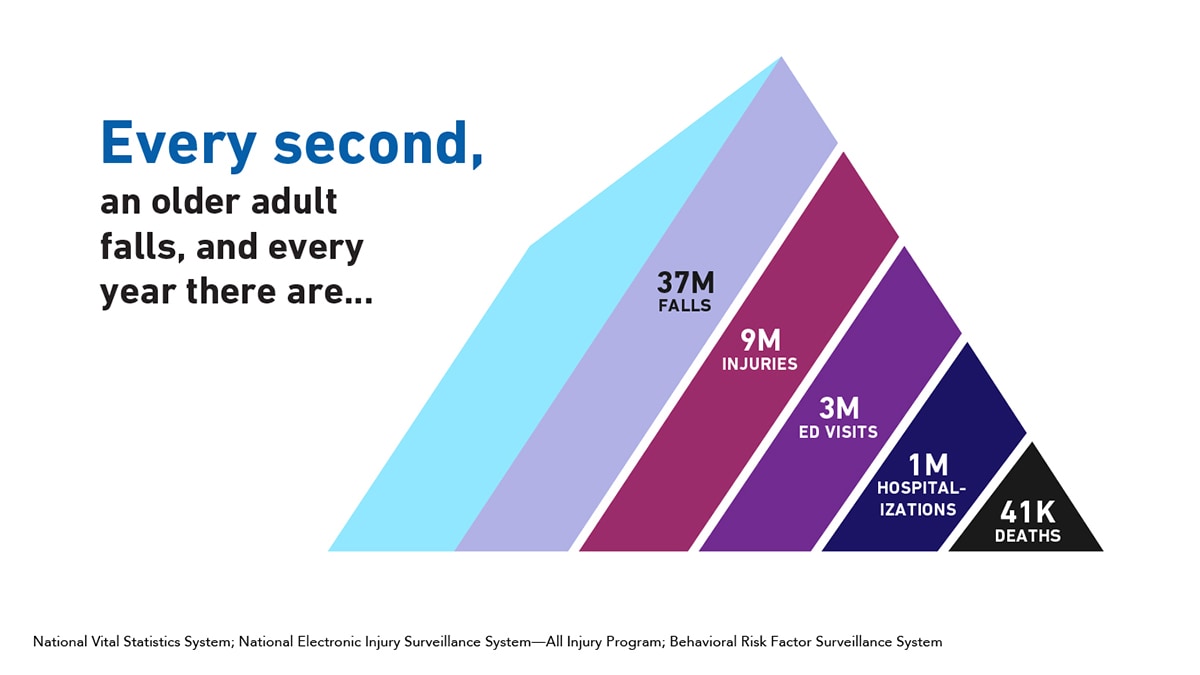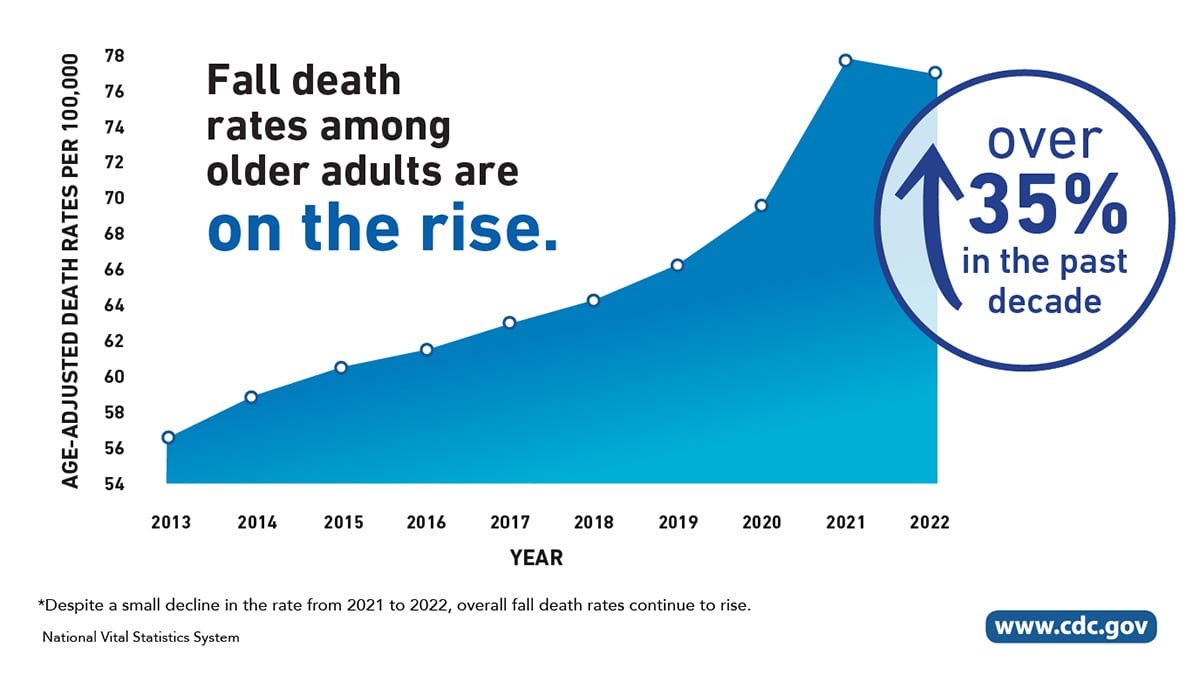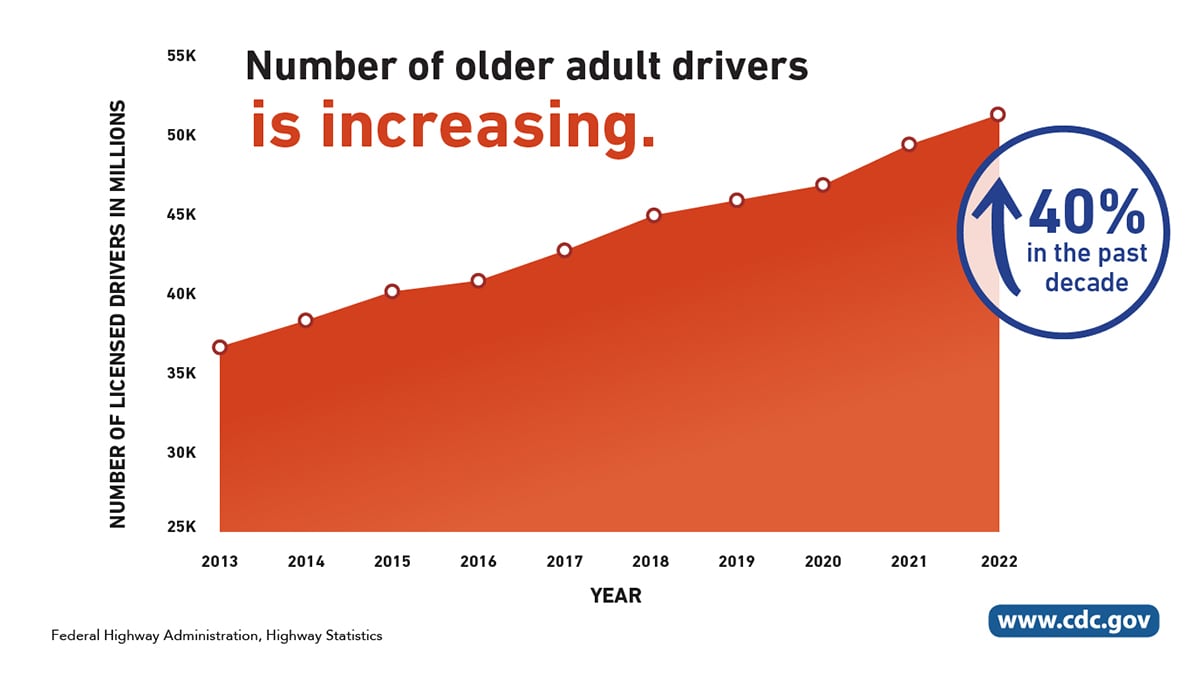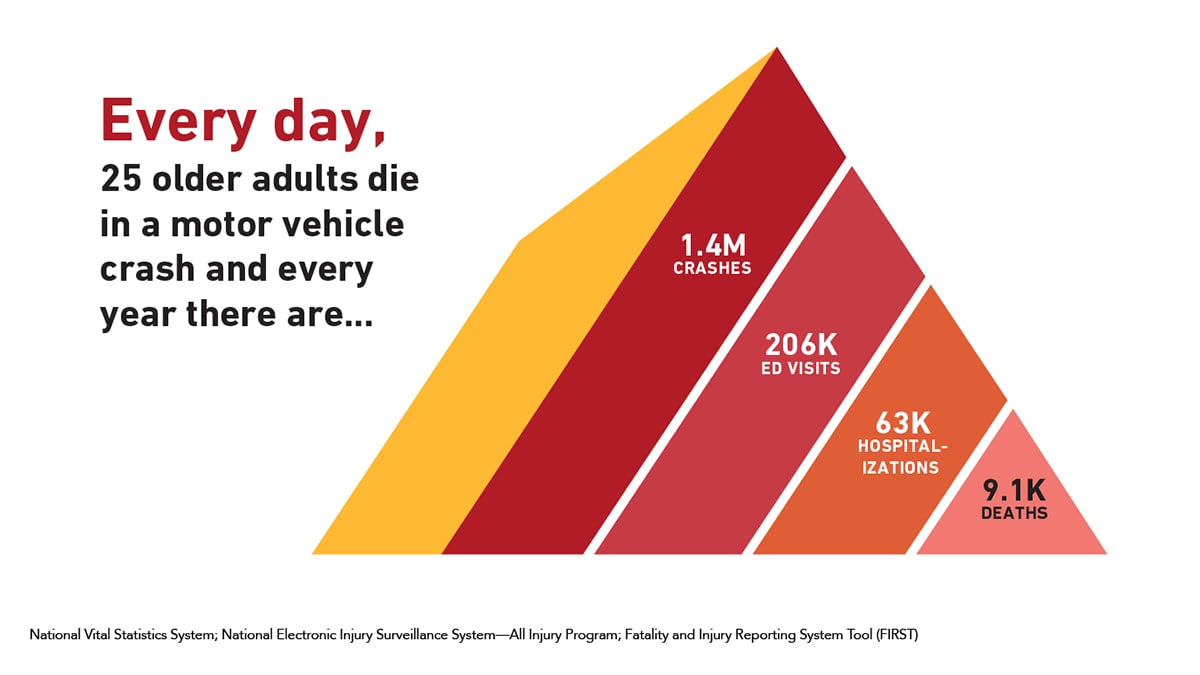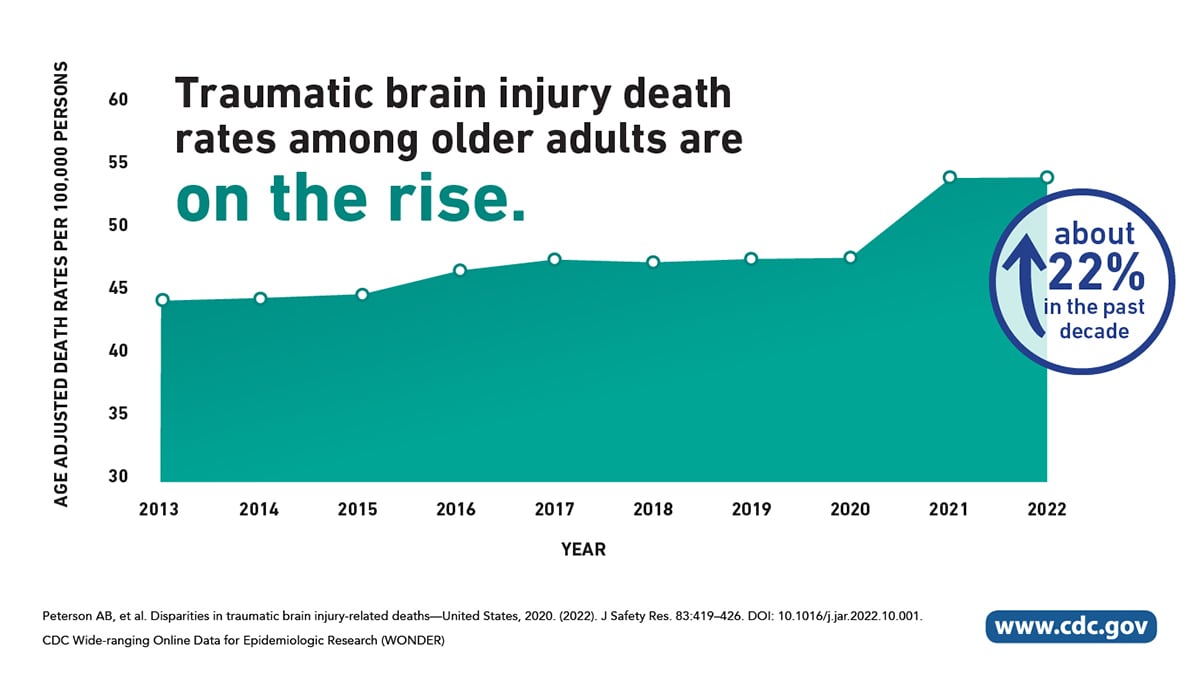Common Injuries as We Age
Still Going Strong focuses on preventing injuries among older adults, because it is a large and growing public health problem facing our nation. Over 10,000 people in the United States turn 65 every day.1 The number of injuries will increase as the population of older adults grows. Healthcare costs associated with these injuries will also increase.
Unintentional injuries have traditionally been the 7th leading cause of death among adults ages 65 and over. During the COVID-19 pandemic, unintentional injuries moved to the 8th leading cause of death among older adults. Falls and motor vehicle crashes are the leading mechanisms of unintentional injury and result in the majority of TBI-related hospitalizations and deaths among older adults.2,3
Each year, 37 million falls occur among older adults age 65 and older.4 While not all falls result in an injury, about 37% of those who fall reported an injury that required medical treatment or restricted their activity for at least one day, resulting in an estimated nine million fall injuries.4 Nearly one million older adults are hospitalized because of a fall injury every year,5 most often due to a head injury or hip fracture. More than 95% of hip fractures are caused by falling,6 and falls are the most common cause of TBI related deaths and hospital admissions.3
Fall death rates are on the rise and have increased 30% in the last 10 years.
There were more than 46 million licensed older drivers, ages 65 and older, in the U.S in 2019.7 That is 1 out of every 5 drivers. This is an increase of 60% since 2000.7 Driving helps older adults stay mobile and independent, but the risk of being injured or killed in a traffic crash increases as we age.
Our vision and ability to reason and remember declines as we age, and physical changes might affect our driving. Certain medical problems increase the risk of car crashes. These include heart disease, dementia, sleep disorders, and limited hearing and vision. Medicines used for sleep, mood, pain, and allergies might affect driving safety. This includes both prescription and over-the-counter medicines.
Over 8,000 older adults died in traffic crashes and nearly 252,000 were treated in emergency departments for crash injuries in 2019.5 This means that each day, 22 older adults are killed and almost 700 are injured in crashes.5
A traumatic brain injury, or TBI, is an injury that affects how the brain works. It may be caused by a:
- Bump, blow, or jolt to the head
- Penetrating head injury (such as when an object enters the skull and harms the brain)
Not all blows or jolts to the head result in a TBI. The severity of a TBI may range from mild, moderate, to severe. Most TBIs that occur in older adults are mild and are commonly called concussions.
TBIs have also increased 30% in the last 10 years.
In 2020, there were over 64,000 TBI-related deaths in the United States.2
Older adults who get a TBI may face health problems that last a few days or the rest of their lives, depending on the severity of the injury.
TBI Effects
Effects of TBI can include short- or long-term problems with:
- Thinking and memory
- Movement
- Sleep
- Sensations such as vision or hearing
- Emotional functioning such as personality changes or depression
TBI is a special health concern for older adults. They have the highest rates of TBI-related hospitalizations and death.3 Older adults can also take longer to recover from a TBI.3
Falls and motor vehicle crashes are two leading causes of TBI-related hospitalizations and deaths in older adults.8
- Colby, Sandra, and Jennifer M. Ortman. “Projections of the size and composition of the U.S. population: 2014 to 2060.” (2015).
- Centers for Disease Control and Prevention. National Center for Health Statistics: Mortality Data on CDC Wide-ranging Online Data for Epidemiologic Research (WONDER). Accessed 2022.
- Centers for Disease Control and Prevention, National Center for Injury Prevention and Control. Surveillance Report of Traumatic Brain Injury-related Hospitalizations and Deaths by Age Group, Sex, and Mechanism of Injury—United States, 2016 and 2017 [PDF – 36 pages]. Atlanta, GA: CDC. Accessed 2021.
- Kakara R, Bergen G, Burns E, Stevens M. Nonfatal and Fatal Falls Among Adults Aged ≥65 Years—United States, 2020–2021. MMWR Morb Mortal Wkly Rep 2023;72:938–943. DOI: 10.15585/mmwr.mm7235a1.
- Centers for Disease Control and Prevention, National Center for Injury Prevention and Control. Web-based Injury Statistics Query and Reporting System (WISQARS). Atlanta, GA: CDC; 2019. Accessed 2021.
- Hayes WC, Myers ER, Morris JN, Gerhart TN, Yett HS, Lipsitz LA. Impact Near the Hip Dominates Fracture Risk in Elderly Nursing Home Residents Who Fall. Calcif Tissue Int 1993;52:192-198.
- U.S. Department of Transportation, Federal Highway Administration. Distribution of Licensed Drivers—2019. Accessed 2021.
- Centers for Disease Control and Prevention, National Center for Injury Prevention and Control. Report to Congress on Traumatic Brain Injury in the United States: Epidemiology and Rehabilitation [PDF – 72 pages]. Atlanta, GA: CDC; 2015.
